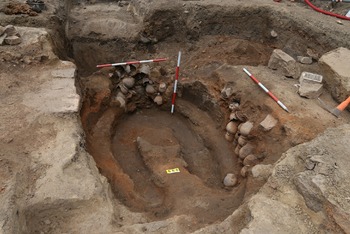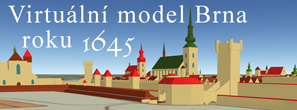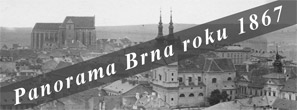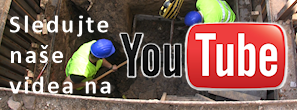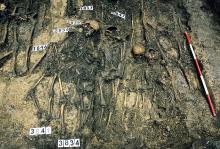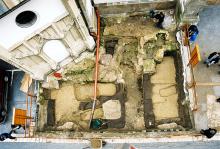Review of Excavations
The focal point of our research activity are rescue archaeological excavations, the main sense of which is to save information and finds being endangered by irretrievable devastation caused by destructive field encroachments. A rescue or as well advance archaeological excavation always consists of a field part and of processing of its results into a finding report, which runs either concurrently to the field part or immediately thereafter. Opening of the field works is usually preceded by a preparation stage of the project.
Preparation stage of excavations serves mainly for a preliminary determination of the extent and character of archaeological situations on the endangered area. On the basis thereof then a concrete sequence of rescue works is stated, and supposed financial costs. The ground of the preparation stage consists in collecting any accessible information on the endangered site, i. e. searching for historical data in archive sources, their editions and in professional literature as well as for the results of older archaeological excavations or building-historical research. Additionally also the results of geological survey can be used to determine the thickness of anthropogenic layers. However, such kind of information on a site is always just informative, it can be precised only through a monitoring excavation (trial trenching). After the study of building project documentation the extent of site endangerment is determined and the information gained then creates a basis for dealing with builders.
The most challenging stage is the proper field research. In fact it is a professional unloading of archaeological landscape under continuous documentation so that the archaeological sources in given area vanish irretrievably. It is to be remembered that all the finds are state property and handling with them is treated by relevant legal standards. The excavation methodics emerges from the British contextual (stratigraphic) method, i. e. a successive uncovering of macroscopically recordable, continuously numbered stratigraphic units (cuttings, layers, walls etc., i. e. remnants of human or natural activities), of which then emerges the “Harris matrix” – a diagram of mutual stratigraphic relations of particular stratigraphic units. With the number of a particular stratigraphic unit then the taken off finds and natural samples are designated. Basic method is usually in details adapted to the conditions of given research site. From any excavation they take a drawing documentation fixed by planimetry and hypsometry, written documentation and photo documentation, at especially significant situations also a video recording. Documentation procedures underlie the internal standards of the company.
Basic processing of results of field research is represented through the laboratory treatment of finds and samplesas well as through evaluation of the whole documentation made. The laboratory processing is created through cleaning and conservation of finds, registration of finds and samples or as well by professional analyses thereof. It is often performed still before the field works are finished to avoid any depreciation of finds and samples in time. Processing of terrain documentation into the form of a finding report usually runs after the field part of excavation was finished. The drawing and measuring documentation is digitalized in computer by help of a tablet and further adjusted, the written documentation is transferred into a special database application enabling further evaluation, in a digital form also the photo and video documentation is registered and archived. The entire information processed in such way is arranged into a finding report containing also the evaluation of so-called site stratigraphy (i. e. chronological relations of recorded remnants of human activity), inventory list of finds and a text part containing the interpretation of all the archaeological situations uncovered as well as the information gained through the archive study during the preparation stage already.
The finding report is deposited in the archive of finding reports of the company Archaia Brno o. p. s. and in the archive of the Institute of Archaeology of the Academy of Sciences of the Czech Republic in Brno where accessible to further study. One exemplar is also given to the building investor. An obligatory excavation output is also the preliminary publishing of its results in the journal Přehled výzkumů (Review of Excavations) issued by the Institute of Archaeology of the Academy of Sciences of the Czech Republic in Brno.
The finds recovered in the course of an excavation are state property and after a laboratory treatment and elaboration of a finding report they are usually deposited in particular regional museums where they can be also further studied. A part of finds is then evaluated and published by the company workers themselves by help of grant projects.
Patrimonium pro futuro
12. 06. 2025 – – zobrazit
